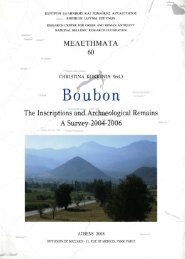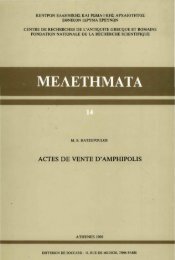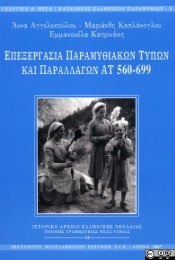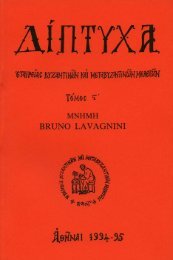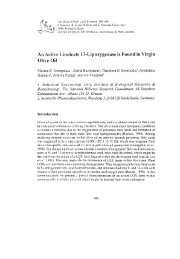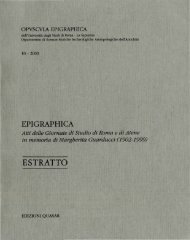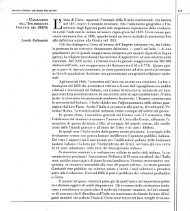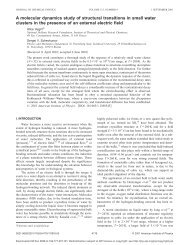roman name-formula
roman name-formula
roman name-formula
- No tags were found...
You also want an ePaper? Increase the reach of your titles
YUMPU automatically turns print PDFs into web optimized ePapers that Google loves.
ecipient himself, too) really possessed civitas<br />
Romana; RMD 123 (AD 179), issued Ulpio Ulpi<br />
f. Herculano, Stobis, seems to be one 41 . It was<br />
essentially the same practice which led to the<br />
formation of (at least) three auxiliary cohorts<br />
civium Romanorum in the "East" during the<br />
Flavio-Trajanic period 42 .<br />
(Ill)<br />
It is a neglected fact that the homes of men whose<br />
<strong>name</strong>s are dealt with in the foregoing pages were<br />
in cities that were either Roman (AD 134, 170:<br />
Stobi, municipium iuris Italici) or included large<br />
communities of civesRomani. The only exception<br />
to that is the Abretten(o) of AD 99, pertaining to<br />
a koinon in northern Asia (Mysia) 43 . The majority<br />
or quasi-totality of these data cannot be assigned<br />
to the category, doubtful in itself when it comes<br />
to documents as official as diplomata, of the "new"<br />
origines 44 .<br />
To prove the point on the crucial rôle of Greek<br />
cities with important communities of Roman<br />
citizens, we have to begin with a discussion —brief<br />
and, as far as possible, free of the circular argument—<br />
of origines whose identification is open<br />
to controversy. Four such cases have been recorded:<br />
Ancyr(a) in AD 82, Larisen(si) in AD 93,<br />
Berens(i) (!) in AD 109, and Hierapol(i) in AD<br />
120. All other items in the catalogue refer either<br />
to the clear Syro/ex Syr(ia) (AD 122,178/190) or<br />
contain toponyms whose identity is virtually<br />
beyond doubt (AD 83, 98, 114, 134, 138, 179) 4 \<br />
Of the two Ancyrae which shouldbe theoretically<br />
considered in an attempt to determine the patria<br />
of the recipient of XVI28, the Galatian is a much<br />
better candidate, being far greaterthan its Phrygian<br />
homonym, and likely to enlist an auxiliary in the<br />
season of Nero's Parthian War 46 . So far as we can<br />
see, no student of diplomata has thought otherwise.<br />
P. A. Holder writes on the recipient of XVI39:<br />
"There are a number of towns called Larissa 47 and<br />
it has been suggested he came from the one in<br />
Thessaly. However, as he was a citizen, his home<br />
town is more likely to have been in an area where<br />
recruits served in the legions or auxilia. No recruits<br />
are known from Thessaly at this time, therefore<br />
Asia Minor is amore suitable province of origin" 48 .<br />
This comment is not convincing, and it has not<br />
38<br />
S. DUSANIC<br />
been followed. On the one hand, there was no<br />
visible reason, in the last years of Nero's reign, to<br />
search as far as Anatolia (or Syria) for a pedes of<br />
an Illyrican auxiliary cohort. On the other, Thessaly<br />
did supply auxiliaries in the early period 49 . We<br />
prefer therefore to identify L. Cassius ' home with<br />
the famous Larisa on the Peneus.<br />
41. His grandfather was presumably a soldier of the coh.<br />
I Hispanorum veterana stationed at Stobi under Trajan"<br />
(Fink [supra, note 2] 217-227, no. 63; cf. F. Papazoglou, in<br />
ANRWU 7. 1 [Berlin-New York 1979] 349f.). Missus<br />
honestamissioneandgiven the citizenship by that Emperor,<br />
the grandfather may have returned to settle in Stobi. The<br />
Ulpiiare otherwise not attested there (F. Papazoglou, Chiron<br />
16 [1986] 234).<br />
42. Holder (supra, note 17) 67f.<br />
43. Not to the fort of Abrit(t)us in Moesia Inferior, as<br />
assumed by some. Its ethnic had a different form, see ILS<br />
2670, castell. Abritanor(um).<br />
44. Forthat notion, RMDHQ418Ï. (Speidel). Note that<br />
the find-spots of our diplomata never coincide with the<br />
areas to which the origines point.<br />
45. It is evident that the Cyrrhus of AD 98 and 138 must<br />
be the Syrian, not the Macedonian, town. The Thracian<br />
alternative should be excluded, without hesitation, in the<br />
case of the origo of AD 114.<br />
46. RMDHQ206Ï. note 74 (Dusanic).<br />
47.Somel5areregisteredintheKEXII(1924)col.840-<br />
873 (cf. Diz. ep. IV 410-19). Of them, five may be envisaged<br />
here: Larisa-on-the Peneus (RE, loc. cit., no. 3), Larisa<br />
Cremaste (no. 2), Larisa on Ossa (no. 4), Larisa in the plain<br />
of theCayster(no. 9; Holder would have thought of it rather<br />
than Larisa Phryconis, no. 8, or Larisa near Tralles), and<br />
Larisa Syriae (no. 12). The importance of the first-mentioned<br />
(in the Roman epoch particularly) far surpassed the<br />
importance of the rest; moreover, the considerations of<br />
military history and geography, briefly dealt with in the<br />
sequel, give Larisa-on-the-Peneus a clear advantage over<br />
its homonyms in Greece and Asia Minor. As to the form<br />
of the ethnic, we prefer, with a number of scholars, the<br />
Larisen(si) (cf. e.g. the ethnic Amphissenses and the like)<br />
to the Larisen(o) printed in CIL III and XVI.<br />
48. Holder (supra, note 17) 125 note 15.<br />
49. Saddington (supra, note 17) 162.



